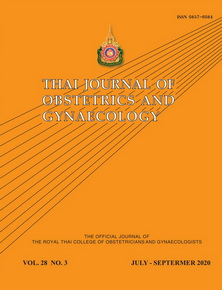Parametrial Invasion in Early-Stage Cervical Cancer
Main Article Content
Abstract
Objective: to determine the rate of parametrial involvement and associated factors among patients who underwent radical hysterectomy and pelvic lymphadenectomy for early-stage cervical cancer.
Materials and Methods: Medical records of 165 patients who had complete data were reviewed. Early stage cervical cancer was defined as cervical cancer stage IA2 to IIA. We excluded patients who presented with neuroendocrine tumors or sarcoma. The lesion size was measured clinically during pelvic examination preceding surgery.
Results: The majority of patients (87.39%) were in stage IB1. One hundred twenty-five (75.8%) patients had tumors smaller than 2 cm in diameter. Pelvic lymph node metastases were noted in twelve (7.3%) patients. Parametrial invasion was noted in six (3.6%) patients.The rate of parametrial invasion was 10% among patients with tumors larger than 2 cm in diameter compared to 1.6% among those with smaller lesions.The rate of parametrial invasion was higher among patients who had deep stromal invasion (13.5% versus 0.9%) and pelvic node metastasis (41.7% versus 0.7%) compared to those without these two pathological factors.
Conclusion: The overall rate of parametrial invasion in patients with early stage cervical cancer in this study was 3.6%.The one significant preoperative predictor for parametrial invasion was tumor size. Significant pathological factors for predicting an increased risk of parametrial invasion included the presence of deep stromal invasion and pelvic lymph node metastasis.
Article Details
References
Torre LA, Bray F, Siegel RL, Ferlay J, Lortet-Tieulent J, Jemal A. Global cancer statistics, 2012. CA Cancer J Clin 2015;65:87-108.
Supoken A, Kietpeerakool C, Laopaiboon M, Lumbiganon P. Simple versus radical hysterectomy with pelvic lymphadenectomy for women with stage IA2-IB1 cervical cancer. Cochrane Database Syst Rev 2016:CD012335.
Querleu D, Morrow CP. Classification of radical hysterectomy. Lancet Oncol 2008;9:297-303.
Verleye L, Vergote I, Reed N, Ottevanger PB. Quality assurance for radical hysterectomy for cervical cancer: the view of the European Organization for Research and Treatment of Cancer--Gynecological Cancer Group (EORTC-GCG). Ann Oncol 2009;20:1631-8.
Viswanathan AN, Lee LJ, Eswara JR, Horowitz NS, Konstantinopoulos PA, Mirabeau-Beale KL, et al. Complications of pelvic radiation in patients treated for gynecologic malignancies. Cancer 2014;120:3870-83.
Laterza RM, Sievert KD, de Ridder D, Vierhout ME, Haab F, Cardozo L, et al. Bladder function after radical hysterectomy for cervical cancer. Neurourol Urodyn 2015;34:309-15.
Kietpeerakool C, Aue-aungkul A, Galaal K, Ngamjarus C, Lumbiganon P. Nerve-sparing radical hysterectomy compared to standard radical hysterectomy for women with early stage cervical cancer (stage Ia2 to IIa). Cochrane Database Syst Rev 2019;2:CD012828.
Barnes W, Waggoner S, Delgado G, Maher K, Potkul R, Barter J, et al. Manometric characterization of rectal dysfunction following radical hysterectomy. Gynecol Oncol 1991;42:116-9.
Charoenkwan K, Srisomboon J, Suprasert P, Tantipalakorn C, Kietpeerakool C. Nerve-sparing class III radical hysterectomy: a modified technique to spare the pelvic autonomic nerves without compromising radicality. Int J Gynecol Cancer 2006;16:1705-12.
Suprasert P, Srisomboon J, Charoenkwan K, Siriaree S, Cheewakriangkrai C, Kietpeerakool C, et al. Twelve years experience with radical hysterectomy and pelvic lymphadenectomy in early stage cervical cancer. J Obstet Gynaecol 2010;30:294-8.
Covens A, Rosen B, Murphy J, Laframboise S, DePetrillo AD, Lickrish G, et al. How important is removal of the parametrium at surgery for carcinoma of the cervix? Gynecol Oncol 2002;84145-9.
Frumovitz M, Sun CC, Schmeler KM, Deavers MT, Dos Reis R, Levenback CF, et al. Parametrial involvement in radical hysterectomy specimens for women with early-stage cervical cancer. Obstet Gynecol 2009;114:93-9.
Kamimori T, Sakamoto K, Fujiwara K, Umayahara K, Sugiyama Y, Utsugi K, et al. Parametrial involvement in FIGO stage IB1 cervical carcinoma diagnostic impact of tumor diameter in preoperative magnetic resonance imaging. Int J Gynecol Cancer 2011;21:349-54.
Kato T, Takashima A, Kasamatsu T, Nakamura K, Mizusawa J, Nakanishi T, et al. Clinical tumor diameter and prognosis of patients with FIGO stage IB1 cervical cancer (JCOG0806-A). Gynecol Oncol 2015;137:34-9.
Kodama J, Kusumoto T, Nakamura K, Seki N, Hongo A, Hiramatsu Y. Factors associated with parametrial involvement in stage IB1 cervical cancer and identification of patients suitable for less radical surgery. Gynecol Oncol 2011;122:491-4.
Steed H, Capstick V, Schepansky A, Honore L, Hiltz M, Faught W. Early cervical cancer and parametrial involvement: is it significant? Gynecol Oncol 2006;103:53-7.
Stegeman M, Louwen M, van der Velden J, ten Kate FJ, den Bakker MA, Burger CW, et al. The incidence of parametrial tumor involvement in select patients with early cervix cancer is too low to justify parametrectomy. Gynecol Oncol 2007;105:475-80.
Vanichtantikul A, Tantbirojn P, Manchana T. Parametrial involvement in women with low-risk, early-stage cervical cancer. Eur J Cancer Care (Engl) 2017;26(5).


